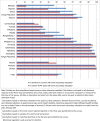Characteristics of women obtaining induced abortions in selected low- and middle-income countries
- PMID: 28355285
- PMCID: PMC5371299
- DOI: 10.1371/journal.pone.0172976
Characteristics of women obtaining induced abortions in selected low- and middle-income countries
Erratum in
-
Correction: Characteristics of women obtaining induced abortions in selected low- and middle-income countries.PLoS One. 2017 May 3;12(5):e0177149. doi: 10.1371/journal.pone.0177149. eCollection 2017. PLoS One. 2017. PMID: 28467483 Free PMC article.
Abstract
Background: In 2010-2014, approximately 86% of abortions took place in low- and middle-income countries (LMICs). Although abortion incidence varies minimally across geographical regions, it varies widely by subregion and within countries by subgroups of women. Differential abortion levels stem from variation in the level of unintended pregnancies and in the likelihood that women with unintended pregnancies obtain abortions.
Objectives: To examine the characteristics of women obtaining induced abortions in LMICs.
Methods: We use data from official statistics, population-based surveys, and abortion patient surveys to examine variation in the percentage distribution of abortions and abortion rates by age at abortion, marital status, parity, wealth, education, and residence. We analyze data from five countries in Africa, 13 in Asia, eight in Europe, and two in Latin America and the Caribbean (LAC).
Results: Women across all sociodemographic subgroups obtain abortions. In most countries, women aged 20-29 obtained the highest proportion of abortions, and while adolescents obtained a substantial fraction of abortions, they do not make up a disproportionate share. Region-specific patterns were observed in the distribution of abortions by parity. In many countries, a higher fraction of abortions occurred among women of high socioeconomic status, as measured by wealth status, educational attainment, and urban residence. Due to limited data on marital status, it is unknown whether married or unmarried women make up a larger share of abortions.
Conclusions: These findings help to identify subgroups of women with disproportionate levels of abortion, and can inform policies and programs to reduce the incidence of unintended pregnancies; and in LMICs that have restrictive abortion laws, these findings can also inform policies to minimize the consequences of unsafe abortion and motivate liberalization of abortion laws. Program planners, policymakers, and advocates can use this information to improve access to safe abortion services, postabortion care, and contraceptive services.
Conflict of interest statement
Figures




Similar articles
-
[Induced abortion: a world perspective].Perspect Int Planif Fam. 1987;(Spec No):12-6. Perspect Int Planif Fam. 1987. PMID: 12269047 Spanish.
-
Characteristics of abortion patients in the United States, 1979 and 1980.Fam Plann Perspect. 1983 Jan-Feb;15(1):5-8, 10-6. Fam Plann Perspect. 1983. PMID: 6394357
-
Induced abortion. Effects of marital status, age and parity on choice of pregnancy termination.Acta Obstet Gynecol Scand. 1994 Mar;73(3):255-60. doi: 10.3109/00016349409023450. Acta Obstet Gynecol Scand. 1994. PMID: 8122509
-
Adolescent childbearing in developing countries: a global review.Stud Fam Plann. 1998 Jun;29(2):117-36. Stud Fam Plann. 1998. PMID: 9664627 Review.
-
Epidemiology of unintended pregnancy and contraceptive use.Am J Obstet Gynecol. 1994 May;170(5 Pt 2):1485-9. doi: 10.1016/s0002-9378(94)05008-8. Am J Obstet Gynecol. 1994. PMID: 8178895 Review.
Cited by
-
Multilevel analysis of factors associated with pregnancy termination in Ethiopia.Ann Med Surg (Lond). 2022 Jul 14;80:104120. doi: 10.1016/j.amsu.2022.104120. eCollection 2022 Aug. Ann Med Surg (Lond). 2022. PMID: 36045825 Free PMC article.
-
Prevalence and Predictors of Contraceptives Use among Women Aged (15-49 years) with Induced Abortion History in Ghana.Adv Prev Med. 2020 Aug 28;2020:2630905. doi: 10.1155/2020/2630905. eCollection 2020. Adv Prev Med. 2020. PMID: 32908708 Free PMC article.
-
Unintended pregnancy, induced abortion and abortion care-seeking experiences among adolescents in Kinshasa, Democratic Republic of Congo: a cross-sectional study.BMJ Open. 2021 Sep 2;11(9):e044682. doi: 10.1136/bmjopen-2020-044682. BMJ Open. 2021. PMID: 34475140 Free PMC article.
-
Reported patterns of pregnancy termination from Demographic and Health Surveys.PLoS One. 2019 Aug 19;14(8):e0221178. doi: 10.1371/journal.pone.0221178. eCollection 2019. PLoS One. 2019. PMID: 31425531 Free PMC article.
-
Preventing first births among adolescents in Mexico City's public abortion programme.BMJ Sex Reprod Health. 2021 Jul;47(3):e9. doi: 10.1136/bmjsrh-2020-200795. Epub 2021 Jan 15. BMJ Sex Reprod Health. 2021. PMID: 33452057 Free PMC article.
References
-
- Bankole A, Singh S, Haas T. Characteristics of women who obtain induced abortion: a worldwide review. Int Fam Plan Perspect. 1999:68–77.
-
- Singh S, Darroch JE. Adding it up: Costs and benefits of contraceptive services. New York: Guttmacher Institute and UNFPA; 2012.
-
- Singh S, Wulf D, Hussain R, Bankole A, Sedgh G. Abortion worldwide: a decade of uneven progress. New York: Guttmacher Institute; 2009.
MeSH terms
Grants and funding
LinkOut - more resources
Full Text Sources
Other Literature Sources

